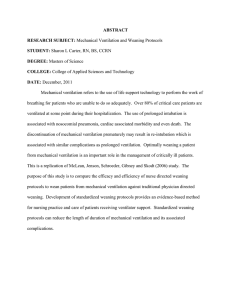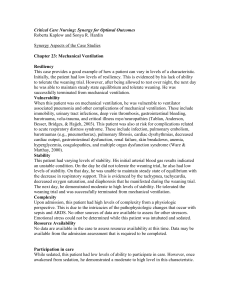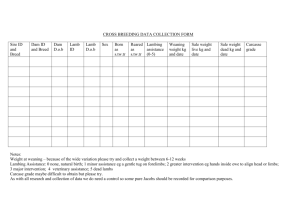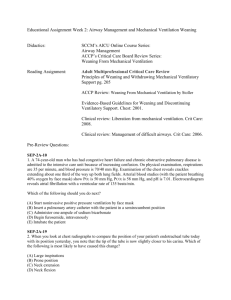Weaning system for mechanical ventilation in the ICU
advertisement
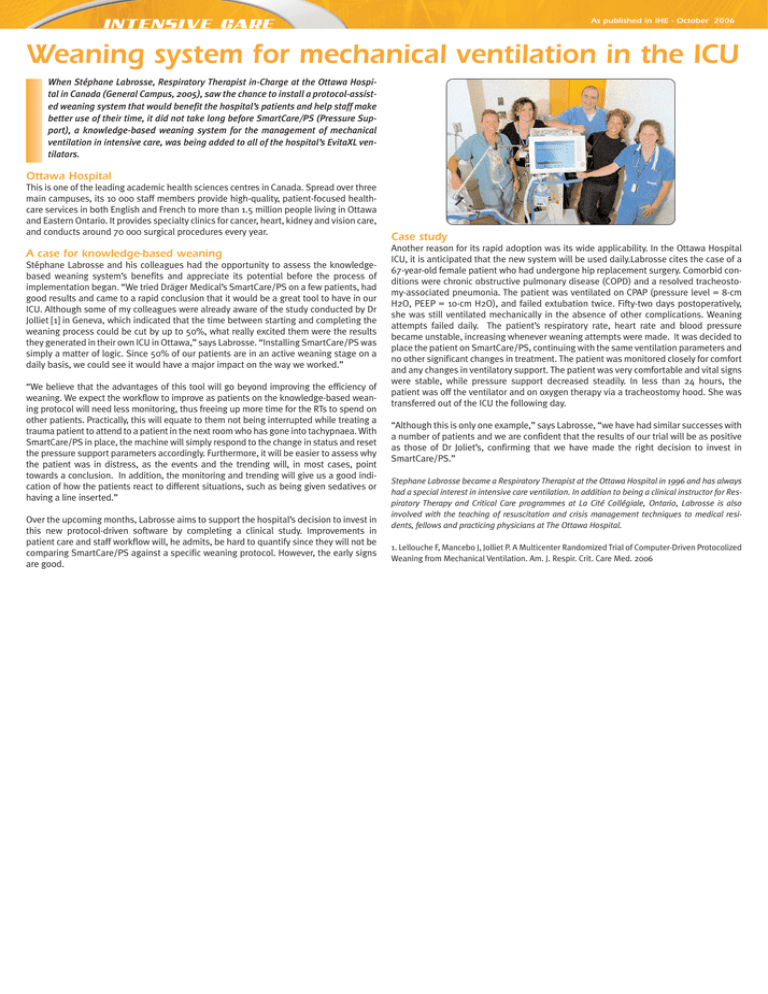
– Page 1 – Issue N°8 – December 2004 As published in IHE - October 2006 INTENSI VE CARE Weaning system for mechanical ventilation in the ICU When Stéphane Labrosse, Respiratory Therapist in-Charge at the Ottawa Hospital in Canada (General Campus, 2005), saw the chance to install a protocol-assisted weaning system that would benefit the hospital’s patients and help staff make better use of their time, it did not take long before SmartCare/PS (Pressure Support), a knowledge-based weaning system for the management of mechanical ventilation in intensive care, was being added to all of the hospital’s EvitaXL ventilators. Ottawa Hospital This is one of the leading academic health sciences centres in Canada. Spread over three main campuses, its 10 000 staff members provide high-quality, patient-focused healthcare services in both English and French to more than 1.5 million people living in Ottawa and Eastern Ontario. It provides specialty clinics for cancer, heart, kidney and vision care, and conducts around 70 000 surgical procedures every year. A case for knowledge-based weaning Stéphane Labrosse and his colleagues had the opportunity to assess the knowledgebased weaning system’s benefits and appreciate its potential before the process of implementation began. “We tried Dräger Medical’s SmartCare/PS on a few patients, had good results and came to a rapid conclusion that it would be a great tool to have in our ICU. Although some of my colleagues were already aware of the study conducted by Dr Jolliet [1] in Geneva, which indicated that the time between starting and completing the weaning process could be cut by up to 50%, what really excited them were the results they generated in their own ICU in Ottawa,” says Labrosse. “Installing SmartCare/PS was simply a matter of logic. Since 50% of our patients are in an active weaning stage on a daily basis, we could see it would have a major impact on the way we worked.” “We believe that the advantages of this tool will go beyond improving the efficiency of weaning. We expect the workflow to improve as patients on the knowledge-based weaning protocol will need less monitoring, thus freeing up more time for the RTs to spend on other patients. Practically, this will equate to them not being interrupted while treating a trauma patient to attend to a patient in the next room who has gone into tachypnaea. With SmartCare/PS in place, the machine will simply respond to the change in status and reset the pressure support parameters accordingly. Furthermore, it will be easier to assess why the patient was in distress, as the events and the trending will, in most cases, point towards a conclusion. In addition, the monitoring and trending will give us a good indication of how the patients react to different situations, such as being given sedatives or having a line inserted.” Over the upcoming months, Labrosse aims to support the hospital’s decision to invest in this new protocol-driven software by completing a clinical study. Improvements in patient care and staff workflow will, he admits, be hard to quantify since they will not be comparing SmartCare/PS against a specific weaning protocol. However, the early signs are good. Case study Another reason for its rapid adoption was its wide applicability. In the Ottawa Hospital ICU, it is anticipated that the new system will be used daily.Labrosse cites the case of a 67-year-old female patient who had undergone hip replacement surgery. Comorbid conditions were chronic obstructive pulmonary disease (COPD) and a resolved tracheostomy-associated pneumonia. The patient was ventilated on CPAP (pressure level = 8-cm H2O, PEEP = 10-cm H2O), and failed extubation twice. Fifty-two days postoperatively, she was still ventilated mechanically in the absence of other complications. Weaning attempts failed daily. The patient’s respiratory rate, heart rate and blood pressure became unstable, increasing whenever weaning attempts were made. It was decided to place the patient on SmartCare/PS, continuing with the same ventilation parameters and no other significant changes in treatment. The patient was monitored closely for comfort and any changes in ventilatory support. The patient was very comfortable and vital signs were stable, while pressure support decreased steadily. In less than 24 hours, the patient was off the ventilator and on oxygen therapy via a tracheostomy hood. She was transferred out of the ICU the following day. “Although this is only one example,” says Labrosse, “we have had similar successes with a number of patients and we are confident that the results of our trial will be as positive as those of Dr Joliet’s, confirming that we have made the right decision to invest in SmartCare/PS.” Stephane Labrosse became a Respiratory Therapist at the Ottawa Hospital in 1996 and has always had a special interest in intensive care ventilation. In addition to being a clinical instructor for Respiratory Therapy and Critical Care programmes at La Cité Collégiale, Ontario, Labrosse is also involved with the teaching of resuscitation and crisis management techniques to medical residents, fellows and practicing physicians at The Ottawa Hospital. 1. Lellouche F, Mancebo J, Jolliet P. A Multicenter Randomized Trial of Computer-Driven Protocolized Weaning from Mechanical Ventilation. Am. J. Respir. Crit. Care Med. 2006
